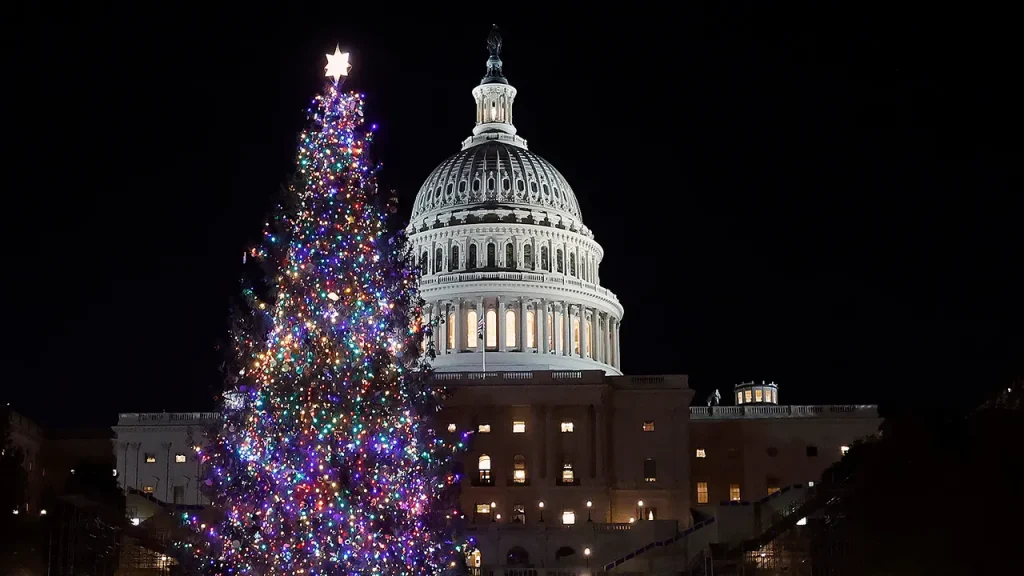The annual tradition of crafting a year-end spending bill on Capitol Hill often resembles a chaotic holiday spectacle, complete with a legislative Christmas tree laden with ornaments of appropriations and mistletoe modifications. This year was no different, as a political Polar Express chugged through Congress, threatening to derail just before reaching its destination. The initial offering was a colossal 1,547-page interim spending bill designed to avert a government shutdown. This behemoth of a bill, packed with provisions ranging from bridge repairs to lawmaker pay raises and hurricane relief, was met with immediate and vociferous opposition from House Republicans. They derided it as a “cram down,” a “dumpster fire,” and “garbage,” arguing that its massive spending contradicted their stated commitment to fiscal responsibility. Despite House Speaker Mike Johnson’s earlier promise to avoid the tradition of a holiday omnibus bill, this initial attempt appeared to embody the very practice he had condemned.
Johnson defended the bill, arguing that unforeseen events, such as devastating hurricanes and the collapse of the Francis Scott Key Bridge, necessitated the expanded scope of the legislation. He insisted it wasn’t a true omnibus, as it didn’t bundle all 12 appropriations bills together. However, the sheer size and breadth of the bill drew comparisons to a Christmas tree laden with ornaments, much to the chagrin of fiscal conservatives. The situation further deteriorated when influential figures outside of Congress, including then-President-elect Trump and Elon Musk, voiced their opposition, effectively torpedoing the bill’s chances of passage. This external pressure, combined with internal Republican dissent, left House leadership scrambling for a Plan B.
The second attempt, a drastically slimmed-down 116-page bill, was designed to be a quick fix. However, this expedited approach fueled further criticism from both sides of the aisle. Democrats mocked Republicans for rushing the bill through without adhering to their own three-day review rule, while others questioned the content and omissions of the truncated legislation. This second attempt also failed spectacularly, falling far short of the necessary votes for passage. The disarray and repeated failures amplified concerns about the government’s ability to avert a shutdown, leaving lawmakers under intense pressure to find a solution.
As the clock ticked toward the shutdown deadline, a third bill emerged. This final version was a product of compromise and negotiation, ultimately garnering enough support to pass both chambers. While critics might have perceived the entire process as a “railroad,” an ironic twist involving an actual railroad momentarily stalled the Senate’s final vote. A Republican senator’s hold on Amtrak board nominees briefly derailed the process, highlighting the unexpected obstacles that can arise even in the final stages of legislative maneuvering. Once this hurdle was cleared, the Senate finally passed the bill, narrowly averting a government shutdown.
The final, streamlined bill focused on essential provisions, including disaster relief and aid for farmers. Unlike its predecessors, it didn’t resemble a lavishly decorated Christmas tree, instead opting for a more pragmatic approach. The bill essentially maintained existing funding levels, providing a temporary solution to keep the government running until March. This resolution, though hard-won, merely postponed the larger budgetary battles to a later date. While a holiday crisis was averted, the looming deadline in March foreshadowed the potential for another round of legislative wrangling.
This year’s spending bill saga underscores the complex and often contentious nature of the appropriations process. The initial attempt at a comprehensive omnibus bill, laden with various provisions, ultimately proved unsustainable due to internal dissent and external pressures. The subsequent failure of a drastically reduced bill highlighted the difficulty of finding common ground under tight deadlines. The final compromise, while averting a shutdown, simply deferred the larger budgetary decisions to a later date. The process served as a reminder of the challenges inherent in navigating the political landscape and the precarious nature of year-end spending negotiations.

